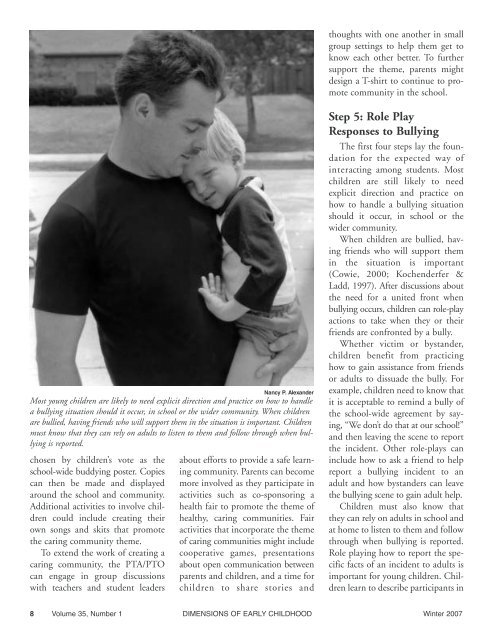Dimensions of Early Childhood - Southern Early Childhood ...
Dimensions of Early Childhood - Southern Early Childhood ...
Dimensions of Early Childhood - Southern Early Childhood ...
You also want an ePaper? Increase the reach of your titles
YUMPU automatically turns print PDFs into web optimized ePapers that Google loves.
thoughts with one another in small<br />
group settings to help them get to<br />
know each other better. To further<br />
support the theme, parents might<br />
design a T-shirt to continue to promote<br />
community in the school.<br />
Nancy P. Alexander<br />
Most young children are likely to need explicit direction and practice on how to handle<br />
a bullying situation should it occur, in school or the wider community. When children<br />
are bullied, having friends who will support them in the situation is important. Children<br />
must know that they can rely on adults to listen to them and follow through when bullying<br />
is reported.<br />
chosen by children’s vote as the<br />
school-wide buddying poster. Copies<br />
can then be made and displayed<br />
around the school and community.<br />
Additional activities to involve children<br />
could include creating their<br />
own songs and skits that promote<br />
the caring community theme.<br />
To extend the work <strong>of</strong> creating a<br />
caring community, the PTA/PTO<br />
can engage in group discussions<br />
with teachers and student leaders<br />
about efforts to provide a safe learning<br />
community. Parents can become<br />
more involved as they participate in<br />
activities such as co-sponsoring a<br />
health fair to promote the theme <strong>of</strong><br />
healthy, caring communities. Fair<br />
activities that incorporate the theme<br />
<strong>of</strong> caring communities might include<br />
cooperative games, presentations<br />
about open communication between<br />
parents and children, and a time for<br />
children to share stories and<br />
Step 5: Role Play<br />
Responses to Bullying<br />
The first four steps lay the foundation<br />
for the expected way <strong>of</strong><br />
interacting among students. Most<br />
children are still likely to need<br />
explicit direction and practice on<br />
how to handle a bullying situation<br />
should it occur, in school or the<br />
wider community.<br />
When children are bullied, having<br />
friends who will support them<br />
in the situation is important<br />
(Cowie, 2000; Kochenderfer &<br />
Ladd, 1997). After discussions about<br />
the need for a united front when<br />
bullying occurs, children can role-play<br />
actions to take when they or their<br />
friends are confronted by a bully.<br />
Whether victim or bystander,<br />
children benefit from practicing<br />
how to gain assistance from friends<br />
or adults to dissuade the bully. For<br />
example, children need to know that<br />
it is acceptable to remind a bully <strong>of</strong><br />
the school-wide agreement by saying,<br />
“We don’t do that at our school!”<br />
and then leaving the scene to report<br />
the incident. Other role-plays can<br />
include how to ask a friend to help<br />
report a bullying incident to an<br />
adult and how bystanders can leave<br />
the bullying scene to gain adult help.<br />
Children must also know that<br />
they can rely on adults in school and<br />
at home to listen to them and follow<br />
through when bullying is reported.<br />
Role playing how to report the specific<br />
facts <strong>of</strong> an incident to adults is<br />
important for young children. Children<br />
learn to describe participants in<br />
8 Volume 35, Number 1 DIMENSIONS OF EARLY CHILDHOOD Winter 2007

















